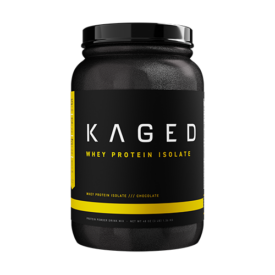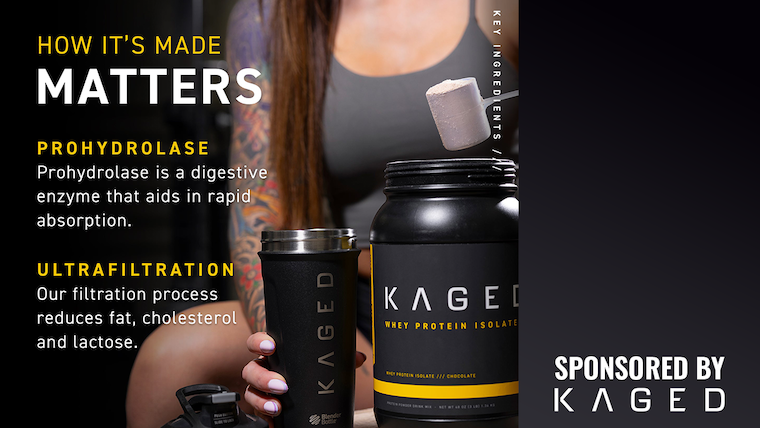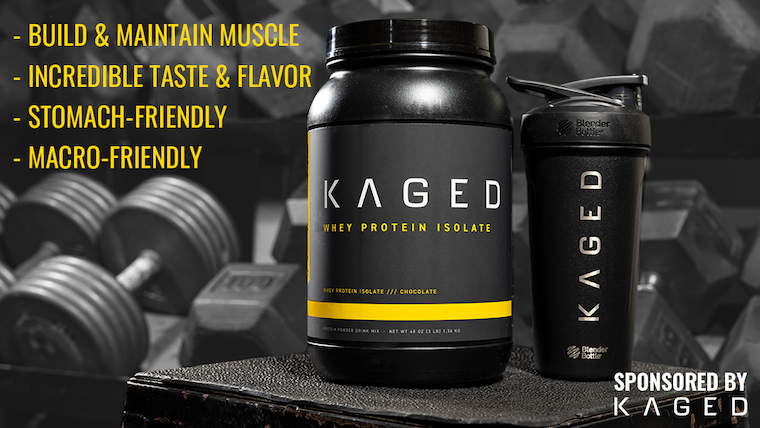Envision your future muscle-bound physique. Your clothes drape perfectly over your torso, your jeans cinch around your waist, and the compliments roll in. You feel better than you’ve ever felt: relaxed, energized, and more self-confident. You can get there by being consistent in the gym. But is that enough, or is that just a prerequisite?
While consistency in the gym has been shown to increase moderate to vigorous physical activity levels and help to better promote long-term weight loss through a “negative energy balance” (i.e., caloric deficit), is training alone enough to build and sustain muscle? (1)(2)
Within that, there is an array of other factors — primarily the necessity for a protein-sufficient diet to coincide with that resistance training. A 2009 randomized control study in Amino Acids found that “whey protein intake close to resistance exercise may…[be] advantageous for muscle hypertrophy. Eleven years later, The Journal of Sports Medicine and Physical Fitness determined, “Supplementation with whey protein, combined with resistance, can increase muscle mass with no effects on muscle strength.” (3)(4)
Whey protein supplementation may alter body composition in favor of additional fat-free mass with no significant changes in body fat. Simply, your physique goals, whether that’s fat loss, muscle gain, or both, are likely doomed if you don’t consume enough quality protein.
One of the simplest ways to add extra protein to your diet is to add a high-quality way protein shake to your routine, like Kaged Whey Protein Isolate. But not all whey protein is created equal. If you want to pack on muscle, whey protein isolate has many advantages over regular whey protein, called whey protein concentrate.

Kaged Whey Protein Isolate packs 25 grams of protein per single-scoop serving and comes in five flavors: S'mores, Chocolate, Cinnamon French Toast, Vanilla, and Chocolate Peanut Butter. Each serving is 110 calories, zero of which is derived from fat or sugar.
Editor’s Note: The content on BarBend is meant to be informative in nature, but it should not be taken as medical advice. When starting a new training regimen and/or diet, it is always a good idea to consult with a trusted medical professional. We are not a medical resource. The opinions and articles on this site are not intended for use as diagnosis, prevention, and/or treatment of health problems. They are not substitutes for consulting a qualified medical professional.
What Does Isolate Mean?
Before diving into the science as to how and why whey protein isolate could be a beneficial addition to your dietary supplement routine, let’s quickly break down the vocabulary.

Per Oxford Languages, the definition of whey is “the watery part of milk that remains after the formation of curds.” That whey is then pasteurized and dried out to form whey concentrate, which has a higher fat content than whey isolate. Whey isolate is whey concentrate that’s been filtered to remove the lactose and fat content. This means that whey protein isolate is a leaner source of protein than its counterpart and is often easier to digest. (5)
Building and Maintaining Muscle
A systemic review in the International Journal of Environmental Research and Public Health determined that “effective hypertrophy-oriented training should comprise a combination of mechanical tension and metabolic stress.” (6)
In terms of resistance training for hypertrophy, this means performing three to six sets per muscle group at a moderate intensity in the six to 12 rep range with approximately 60-second rest intervals between sets. As strength increases, so should training volume — this review suggested 12-28 sets per muscle group per week.

Building muscle is a simplified way of saying muscle protein synthesis (MPS), the muscle’s adaptation to the stimulus (read: resistance training) it endures. That adaptation is, ideally, growth. To support that MPS, adequate nutrition is essential to not leave gains on the table. A vital part of that nutrition is sufficient daily protein intake — think 1.6 to 2.2 grams of protein per kilogram of body weight per day. (7)
For example, a 160-pound person should aim for a range of 116 to 160 grams of protein per day. Assuming that person has three meals per day, each meal would need to consist of approximately 39 to 53 grams of protein. That’s a lot of protein to scarf down. An easily digestible protein supplement like Kaged Whey Protein Isolate is a low-calorie means of hitting that daily protein target without tacking on unwanted excess calories.
Are All Whey Isolates Created Equal?
Almost any whey isolate will be cleaner than other whey proteins, assuming it’s third-party tested, so you know that what’s on the label is on the bottle. However, not all isolates are created equal.
Many whey isolates use cleaner filtration processes to get rid of even more lactose, fat, and other unwanted ingredients. This ultrafiltration isn’t commonplace, so it’s something to look for when choosing whey.
Second, even premium whey isolate can be hard on some people’s stomachs. Some products include ingredients like ProHydrolase®, a patented enzyme blend that helps you digest protein, so you can use more of it to fuel your muscles. Kaged Whey Protein Isolate checks both of these boxes.
Find Your Whey, Isolate Your Goals
When supplementing your diet to support your training to reach your dream physique, Kaged Whey Protein Isolate can help you get your daily protein needs.
If you’re putting in the effort in the gym, don’t squander it by depriving your body of the protein it needs to rebuild itself to grow bigger and better. Kaged Whey Protein Isolate comes with 41 servings per container and is offered in five flavors: S’mores, Chocolate, Cinnamon French Toast, Vanilla, and Chocolate Peanut Butter.

Kaged Whey Protein Isolate packs 25 grams of protein per single-scoop serving and comes in five flavors: S'mores, Chocolate, Cinnamon French Toast, Vanilla, and Chocolate Peanut Butter. Each serving is 110 calories, zero of which is derived from fat or sugar.
References
-
Schumacher, L. M., Thomas, J. G., Raynor, H. A., Rhodes, R. E., O’Leary, K. C., Wing, R. R., & Bond, D. S. (2019). Relationship of Consistency in Timing of Exercise Performance and Exercise Levels Among Successful Weight Loss Maintainers. Obesity (Silver Spring, Md.), 27(8), 1285–1291. https://doi.org/10.1002/oby.22535
-
Swift, D. L., McGee, J. E., Earnest, C. P., Carlisle, E., Nygard, M., & Johannsen, N. M. (2018). The Effects of Exercise and Physical Activity on Weight Loss and Maintenance. Progress in cardiovascular diseases, 61(2), 206–213. https://doi.org/10.1016/j.pcad.2018.07.014
-
Hulmi, J. J., Kovanen, V., Selänne, H., Kraemer, W. J., Häkkinen, K., & Mero, A. A. (2009). Acute and long-term effects of resistance exercise with or without protein ingestion on muscle hypertrophy and gene expression. Amino acids, 37(2), 297–308. https://doi.org/10.1007/s00726-008-0150-6
-
Duarte, N. M., Cruz, A. L., Silva, D. C., & Cruz, G. M. (2020). Intake of whey isolate supplement and muscle mass gains in young healthy adults when combined with resistance training: a blinded randomized clinical trial (pilot study). The Journal of sports medicine and physical fitness, 60(1), 75–84. https://doi.org/10.23736/S0022-4707.19.09741-X
-
Sousa, R., Portmann, R., Dubois, S., Recio, I., & Egger, L. (2020). Protein digestion of different protein sources using the INFOGEST static digestion model. Food research international (Ottawa, Ont.), 130, 108996. https://doi.org/10.1016/j.foodres.2020.108996
-
Krzysztofik, M., Wilk, M., Wojdała, G., & Gołaś, A. (2019). Maximizing Muscle Hypertrophy: A Systematic Review of Advanced Resistance Training Techniques and Methods. International journal of environmental research and public health, 16(24), 4897. https://doi.org/10.3390/ijerph16244897
-
Stokes, T., Hector, A. J., Morton, R. W., McGlory, C., & Phillips, S. M. (2018). Recent Perspectives Regarding the Role of Dietary Protein for the Promotion of Muscle Hypertrophy with Resistance Exercise Training. Nutrients, 10(2), 180. https://doi.org/10.3390/nu10020180
Featured image courtesy of Kaged.